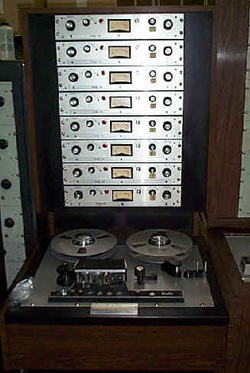WEBSITES
Alliance for Permanent Access

Alliance for Permanent Access (APA). (2010). [website] Retrieved from
http://www.alliancepermanentaccess.eu/about-the-apa.html
Dedicated exclusively to Digital Preservation, The Alliance for Permanent Access is a European organization whose members include national and pan-European research organizations, research support organizations such as data centers and archives, libraries and publishers, and research funders. Its members provide support for the whole lifecycle of scientific research in Europe. Their main impetus is the sharing and interoperability for successful practice, development of consortia for projects, and joint activities.
http://www.alliancepermanentaccess.eu/about-the-apa.html
Dedicated exclusively to Digital Preservation, The Alliance for Permanent Access is a European organization whose members include national and pan-European research organizations, research support organizations such as data centers and archives, libraries and publishers, and research funders. Its members provide support for the whole lifecycle of scientific research in Europe. Their main impetus is the sharing and interoperability for successful practice, development of consortia for projects, and joint activities.
Blue Ribbon Task Force
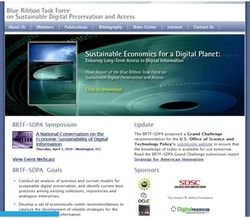
Blue Ribbon Task Force on Sustainable Digital Preservation and
Access. (2007). [website]. Retrieved from
http://brtf.sdsc.edu/index.html.
The Blue Ribbon Task Force was created n late 2007 funded by the
National Science Foundation and the Andrew W. Mellon Foundation
in partnership with the Library of Congress. The task force is made
up of a number of members of Universities, Corporations, and
Independent Consultants that hold reputable fields across the United
States. They are dedicated to the underlying potential of the
Information Age and its paradigm – shifting access to digital
information is the assumption that key information will be there when
we want it, where we want it, and for the foreseeable future. In their
website they supply a number of publications, articles, conferences,
symposiums and newsletters dedicated to the research and efforts of Sustainability and Preservation for the future of Digital Libraries. This Task Force and website is important because it has oodles of valuable and viable up to date information for individuals who are working in the Digital Field.
Access. (2007). [website]. Retrieved from
http://brtf.sdsc.edu/index.html.
The Blue Ribbon Task Force was created n late 2007 funded by the
National Science Foundation and the Andrew W. Mellon Foundation
in partnership with the Library of Congress. The task force is made
up of a number of members of Universities, Corporations, and
Independent Consultants that hold reputable fields across the United
States. They are dedicated to the underlying potential of the
Information Age and its paradigm – shifting access to digital
information is the assumption that key information will be there when
we want it, where we want it, and for the foreseeable future. In their
website they supply a number of publications, articles, conferences,
symposiums and newsletters dedicated to the research and efforts of Sustainability and Preservation for the future of Digital Libraries. This Task Force and website is important because it has oodles of valuable and viable up to date information for individuals who are working in the Digital Field.
CLIR

Council on Library and Information Resources (CLIR). (2010). [website].
Retrieved from http://www.clir.org/dlf.html
CLIR is a nonprofit organization that works to maintain and improve access to information for generations to come. In partnership with other institutions, they help create services that expand the concept of "library" and supports the providers and preservers of information. They strive to foster new approaches to the management of digital and nondigital information resources so that they will be available in the future. As part of their partnership they also oversee the Digital Library Federation which is a consortium of libraries and related agencies that are pioneering the use of electronic-information technologies to extend their collections and services.
Retrieved from http://www.clir.org/dlf.html
CLIR is a nonprofit organization that works to maintain and improve access to information for generations to come. In partnership with other institutions, they help create services that expand the concept of "library" and supports the providers and preservers of information. They strive to foster new approaches to the management of digital and nondigital information resources so that they will be available in the future. As part of their partnership they also oversee the Digital Library Federation which is a consortium of libraries and related agencies that are pioneering the use of electronic-information technologies to extend their collections and services.
CRL

Center for Research Libraries (CRL). (2010). [website]. Retrieved
from http://www.crl.edu/
The Center for Research Libraries (CRL) is based in Chicago and offers a referral and consultation service for institutions looking to explore Digital Preservation. They gather information and report on digital repositories that preserve source materials of interest.
http://www.crl.edu/archiving-preservation/digital-archives/
from http://www.crl.edu/
The Center for Research Libraries (CRL) is based in Chicago and offers a referral and consultation service for institutions looking to explore Digital Preservation. They gather information and report on digital repositories that preserve source materials of interest.
http://www.crl.edu/archiving-preservation/digital-archives/
DELOS

Network of Excellence on Digital Libraries (DELOS). (2004).
http://www.delos.info/index.phpoption=com_frontpage&Itemid=1
The main objective of the DELOS is to contribute to the development
of the enabling technologies so that its vision of digital libraries may
become a reality. They also aim at disseminating knowledge of
digital library technologies to many diverse application domains.
This network can provide specific user communities with access to
advanced digital library technologies, services, testbeds, and the
necessary expertise and knowledge. This Commission is a support
system for digital libraries to find information. It also has its own
open digital library.
http://www.delos.info/index.phpoption=com_frontpage&Itemid=1
The main objective of the DELOS is to contribute to the development
of the enabling technologies so that its vision of digital libraries may
become a reality. They also aim at disseminating knowledge of
digital library technologies to many diverse application domains.
This network can provide specific user communities with access to
advanced digital library technologies, services, testbeds, and the
necessary expertise and knowledge. This Commission is a support
system for digital libraries to find information. It also has its own
open digital library.
DPC
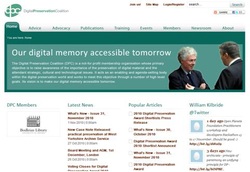
Digital Preservation Coalition (DPC). (2009).[website]. Retrieved from
http://www.dpconline.org/
The Digital Preservation Coalition was established in 2001 to
address the urgent challenges of securing the preservation of digital
resources in the UK and to work with others internationally to secure
our global digital memory and knowledge base. This website
provides advice, advocacy, publications, training, events, and news.
Their mission is to “enable and act as a catalyst to support its
members to ensure long term access to and management of their
digital assets; to collaborate with our nations and international
partners to take forward the digital preservation and asset management agenda; and to act as a broker and an agent of knowledge transfer amongst its membership.” They identify five areas of work: Leadership, influencing and collaboration; sharing and disseminating knowledge; This Coalition website is important because it enriches its members’ experience; empowering and developing members’ workforce; and assuring preservation and sustainability
http://www.dpconline.org/advice/preservationhandbook/introduction?format=pdf
http://www.dpconline.org/
The Digital Preservation Coalition was established in 2001 to
address the urgent challenges of securing the preservation of digital
resources in the UK and to work with others internationally to secure
our global digital memory and knowledge base. This website
provides advice, advocacy, publications, training, events, and news.
Their mission is to “enable and act as a catalyst to support its
members to ensure long term access to and management of their
digital assets; to collaborate with our nations and international
partners to take forward the digital preservation and asset management agenda; and to act as a broker and an agent of knowledge transfer amongst its membership.” They identify five areas of work: Leadership, influencing and collaboration; sharing and disseminating knowledge; This Coalition website is important because it enriches its members’ experience; empowering and developing members’ workforce; and assuring preservation and sustainability
http://www.dpconline.org/advice/preservationhandbook/introduction?format=pdf
DPE

Digital Preservation Europe (DPE). (2010). [website]. Retrieved from
http://www.digitalpreservationeurope.eu/
Digital Preservation Europe (DPE) is a European collaboration that
recognizes that digital memory needs constant management, using
new techniques and processes, to contain such risks as
technological obsolescence. They also recognize that digital
preservation is too big an issue for individual institutions or even
sectors to address independently. They attempt to foster
collaboration and synergies between many existing national
initiatives across the European Research Area and they stress the
need to improve coordination, cooperation and consistency in current preservation of digital materials.
http://www.digitalpreservationeurope.eu/what-is-digital-preservation/
http://www.digitalpreservationeurope.eu/
Digital Preservation Europe (DPE) is a European collaboration that
recognizes that digital memory needs constant management, using
new techniques and processes, to contain such risks as
technological obsolescence. They also recognize that digital
preservation is too big an issue for individual institutions or even
sectors to address independently. They attempt to foster
collaboration and synergies between many existing national
initiatives across the European Research Area and they stress the
need to improve coordination, cooperation and consistency in current preservation of digital materials.
http://www.digitalpreservationeurope.eu/what-is-digital-preservation/
ICPSR
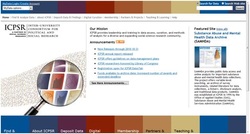
Cornell University Library. Inter-university Consortium for Political and
SocialResearch (ICPSR). (2007). [website]. Retrieved from
http://www.icpsr.umich.edu/dpm/.
The Cornell University created Inter-university Consortium for Political
and Social Research (ICPSR). It is an international consortium of
about 700 academic institutions and research organizations. ICPSR
provides leadership and training in data access, curation, and
methods of analysis for the social science and research community.
The ICPSR also maintains a data archive and hosts sixteen specialized collection. The website provides annual reports, guidelines on data, conferences and fairs, and featured libraries. This consortium is important if an academic library or institution is looking for resources, support, and training.
SocialResearch (ICPSR). (2007). [website]. Retrieved from
http://www.icpsr.umich.edu/dpm/.
The Cornell University created Inter-university Consortium for Political
and Social Research (ICPSR). It is an international consortium of
about 700 academic institutions and research organizations. ICPSR
provides leadership and training in data access, curation, and
methods of analysis for the social science and research community.
The ICPSR also maintains a data archive and hosts sixteen specialized collection. The website provides annual reports, guidelines on data, conferences and fairs, and featured libraries. This consortium is important if an academic library or institution is looking for resources, support, and training.
META ARCHIVE

The MetaArchive Cooperative. (2010). [website]. Retrieved from
http://www.metaarchive.org/
The MetaArchive Cooperative provides low-cost, high-impact preservation
services to help ensure the long-term accessibility of the digital assets of
universities, libraries, museums, and other cultural heritage institutions. The
MetaArchive Cooperative provides low-cost, high-impact preservation services to help ensure the long-term accessibility of the digital assets of universities, libraries, museums, and other cultural heritage institutions.
http://www.metaarchive.org/
The MetaArchive Cooperative provides low-cost, high-impact preservation
services to help ensure the long-term accessibility of the digital assets of
universities, libraries, museums, and other cultural heritage institutions. The
MetaArchive Cooperative provides low-cost, high-impact preservation services to help ensure the long-term accessibility of the digital assets of universities, libraries, museums, and other cultural heritage institutions.
NDIIPP
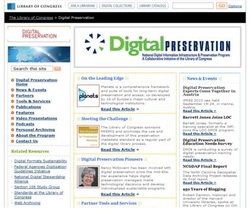
Library of congress. National digital information infrastructure &
preservation program: A collaborative initiative of the library of
congress(NDIIPP). (2010). [website].Retrieved from
http://www.digitalpreservation.gov/.
This Programs website is dedicated to a national strategy to collect,
preserve and make available significant digital content for current and
future generations. This program is networked with over 130 partners
from across the nation. The website features programs, articles,
blogs, RSS feeds, podcasts, tools, and publications provided by the
Library of Congress. This website is a great reference to links to all
information about the preservation and sustainability of Libraries.
preservation program: A collaborative initiative of the library of
congress(NDIIPP). (2010). [website].Retrieved from
http://www.digitalpreservation.gov/.
This Programs website is dedicated to a national strategy to collect,
preserve and make available significant digital content for current and
future generations. This program is networked with over 130 partners
from across the nation. The website features programs, articles,
blogs, RSS feeds, podcasts, tools, and publications provided by the
Library of Congress. This website is a great reference to links to all
information about the preservation and sustainability of Libraries.
NEDCC

The Northeast Document Conservation Center (NEDCC). (2010). [website].
Retrieved from http://www.nedcc.org/services
The Northeast Document Conservation Center (NEDCC) is dedicated to
improving the conservation efforts of libraries, archives, historical
organizations, museums, and other repositories; and to provide the high
quality service to institutions without in-house conservation facilities or those
that seek specialized expertise; and to provide leadership in the preservation and conservation fields.They offer an online Preservation Planning Webinar Series that will help institutions develop a plan for the preservation of collection materials.
http://www.nedcc.org/curriculum/imagelibrary.php?m=Class1
Retrieved from http://www.nedcc.org/services
The Northeast Document Conservation Center (NEDCC) is dedicated to
improving the conservation efforts of libraries, archives, historical
organizations, museums, and other repositories; and to provide the high
quality service to institutions without in-house conservation facilities or those
that seek specialized expertise; and to provide leadership in the preservation and conservation fields.They offer an online Preservation Planning Webinar Series that will help institutions develop a plan for the preservation of collection materials.
http://www.nedcc.org/curriculum/imagelibrary.php?m=Class1
NISO

National Information Standards Organization (NISO). (2010).
[webiste]. Retrieved from http://www.niso.org/home/
Founded in 1939, the National Information Standards Organization,
(NISO) is a non-profit association accredited by the American National
Standards Institute (ANSI), that “identifies, develops, maintains, and
publishes technical standards to manage information in our changing and ever-more digital environment. NISO standards apply both traditional and new technologies to the full range of information-related needs, including retrieval, re-purposing, storage, metadata, and preservation.” They also are responsible for the Framework for Guidance for Building Good Digital Collections which is considered an industry standard and will be discussed below.
[webiste]. Retrieved from http://www.niso.org/home/
Founded in 1939, the National Information Standards Organization,
(NISO) is a non-profit association accredited by the American National
Standards Institute (ANSI), that “identifies, develops, maintains, and
publishes technical standards to manage information in our changing and ever-more digital environment. NISO standards apply both traditional and new technologies to the full range of information-related needs, including retrieval, re-purposing, storage, metadata, and preservation.” They also are responsible for the Framework for Guidance for Building Good Digital Collections which is considered an industry standard and will be discussed below.
PENROSE LIBRARY
The Digital Initiates Department at Penrose Library at the University of Denver is an up-and-coming DL that runs upon the Fedora system and is neat.
http://library.du.edu/site/about/DI/digitalContentManagement.php
http://library.du.edu/site/about/DI/digitalContentManagement.php
OUR RESOURCE
This is a resource website that we put together just to show some of the support and media available for Digital Preservation
http://digitalpreservation4804.blogspot.com/
http://digitalpreservation4804.blogspot.com/
POLICIES, MANUALS, GUIDES
Webb, C. (2003). UNESCO: Guidelines for the preservation of digital heritage. Retrieved from
http://unesdoc.unesco.org/images/0013/001300/130071e.pdf
The Guidelines presents the key principles to be adopted by UNESCO's Member States in order to ensure the ongoing
protection and preservation of digital heritage. The charter outlines the arguments for protect against the loss of digital
heritage, the measures required to protect and preserve digital heritage and the roles and responsibilities of UNESCO
and Member States towards ensuring the preservation of digital heritage.
Jones, M., & Beagrie,N. (2008). Preservation management of digital materials: A handbook. Retrieved from
http://www.imaginar.org/dppd/DPPD/139%20pp%20Handbook.pdf
The Preservation Management of Digital Material Handbook is maintained by the Digital Preservation Coalition in
collaboration with the National Library of Australia and the PADI Gateway.The guidelines provide advice on a significant
range of issues relevant to creation, management and preservation of digital resources. They include detailed advice
on technical issues relating to digital preservation formats and technology, as well as control issues relating to
management of work processes and personnel.
John Hopkins University Library. (2008) Jschololarship digital preservation policy. [website]. Retrieved from
http://www.library.jhu.edu/collections/institutionalrepository/irpreservationpolicy.html
This website is the John Hopkins University – The Sheridan Libraries digital preservation policy. This document states
elements of the digital preservation specifically for their digital library. Elements include: standards and best practices,
preservation guarantees, Content format types, Image capture standards: converting from analog to digital, institutional
and operation roles and repositories, and managed activities. This policy document is a great references of standards
for a digital library that includes diagrams of the expectancies in these areas particularly to their library.
Cornell University Library. Inter-university Consortium for Political and Social Research (ICPSR). (2007). Digital
preservation management: Implementing short-term strategies for long-term problems. [website]. Retrieved from
http://www.icpsr.umich.edu/dpm/dpm-eng/eng_index.html
The Cornell University has developed a website is a tutorial and workshop due to the lack of institutional organization
and response. The basis of the tutorial and workshops is an integrated model that combines the organizational
context, technological implementation, and resource framework. The tutorial is set up to touch on, “setting the state,”
obsolescence & physical threats,” “foundations,” “challenges,” and “program elements.” You can even take a “Digital
Preservation Cosmos Quiz” to determine if this tutorial and workshops will work for your particular preservation project.
TRAC- The Trustworthy Repositories Audit and Certification
http://www.crl.edu/sites/default/files/attachments/pages/trac_0.pdf
NARA and OCLC created a joint task force to specifically address digital repository certification. The goal of the RLG-NARA Task Force on Digital Repository Certification has been to develop criteria to identify digital repositories capable of reliably storing, migrating, and providing access to digital collections.
NISO Guidelines
http://framework.niso.org
NISO is where content publishers, libraries, and software developers turn for information industry standards that allow them to work together. Through NISO, all of these communities are able to collaborate on mutually accepted standards. They publish the guidelines to ensure maximum interoperability and preservation effectiveness.
GDPP Guide to Distributed Digital Preservation published by the Meta Archive Coalition
http://www.metaarchive.org/GDDP
The provides low-cost, high-impact preservation services to help ensure the long-term accessibility of the digital assets of universities, libraries, museums, and other cultural heritage institutions. This guide is written with a broad audience in mind that includes librarians, curators, archivists, scholars, technologists, lawyers, and administrators.
http://unesdoc.unesco.org/images/0013/001300/130071e.pdf
The Guidelines presents the key principles to be adopted by UNESCO's Member States in order to ensure the ongoing
protection and preservation of digital heritage. The charter outlines the arguments for protect against the loss of digital
heritage, the measures required to protect and preserve digital heritage and the roles and responsibilities of UNESCO
and Member States towards ensuring the preservation of digital heritage.
Jones, M., & Beagrie,N. (2008). Preservation management of digital materials: A handbook. Retrieved from
http://www.imaginar.org/dppd/DPPD/139%20pp%20Handbook.pdf
The Preservation Management of Digital Material Handbook is maintained by the Digital Preservation Coalition in
collaboration with the National Library of Australia and the PADI Gateway.The guidelines provide advice on a significant
range of issues relevant to creation, management and preservation of digital resources. They include detailed advice
on technical issues relating to digital preservation formats and technology, as well as control issues relating to
management of work processes and personnel.
John Hopkins University Library. (2008) Jschololarship digital preservation policy. [website]. Retrieved from
http://www.library.jhu.edu/collections/institutionalrepository/irpreservationpolicy.html
This website is the John Hopkins University – The Sheridan Libraries digital preservation policy. This document states
elements of the digital preservation specifically for their digital library. Elements include: standards and best practices,
preservation guarantees, Content format types, Image capture standards: converting from analog to digital, institutional
and operation roles and repositories, and managed activities. This policy document is a great references of standards
for a digital library that includes diagrams of the expectancies in these areas particularly to their library.
Cornell University Library. Inter-university Consortium for Political and Social Research (ICPSR). (2007). Digital
preservation management: Implementing short-term strategies for long-term problems. [website]. Retrieved from
http://www.icpsr.umich.edu/dpm/dpm-eng/eng_index.html
The Cornell University has developed a website is a tutorial and workshop due to the lack of institutional organization
and response. The basis of the tutorial and workshops is an integrated model that combines the organizational
context, technological implementation, and resource framework. The tutorial is set up to touch on, “setting the state,”
obsolescence & physical threats,” “foundations,” “challenges,” and “program elements.” You can even take a “Digital
Preservation Cosmos Quiz” to determine if this tutorial and workshops will work for your particular preservation project.
TRAC- The Trustworthy Repositories Audit and Certification
http://www.crl.edu/sites/default/files/attachments/pages/trac_0.pdf
NARA and OCLC created a joint task force to specifically address digital repository certification. The goal of the RLG-NARA Task Force on Digital Repository Certification has been to develop criteria to identify digital repositories capable of reliably storing, migrating, and providing access to digital collections.
NISO Guidelines
http://framework.niso.org
NISO is where content publishers, libraries, and software developers turn for information industry standards that allow them to work together. Through NISO, all of these communities are able to collaborate on mutually accepted standards. They publish the guidelines to ensure maximum interoperability and preservation effectiveness.
GDPP Guide to Distributed Digital Preservation published by the Meta Archive Coalition
http://www.metaarchive.org/GDDP
The provides low-cost, high-impact preservation services to help ensure the long-term accessibility of the digital assets of universities, libraries, museums, and other cultural heritage institutions. This guide is written with a broad audience in mind that includes librarians, curators, archivists, scholars, technologists, lawyers, and administrators.
CONFERENCES
Council on Library and Information Resources (CLIR). (2002). The State of Digital Preservation: An International
Perspective. Proceedings of the Institutes for Information Science. Washington D.C.
These proceedings, sponsored by CLIR, mark one of the first major gatherings of professionals to discuss the state of
Digital Preservation not only in United States but abroad. This paper gets into major detail about the theory and
practice of Digital Libraries as well as exhaustive analysis of options and planning for the future which includes
presentations from Europe and Australia.
Guy,M. (2010). Blue ribbon task force symposium on sustainable digital preservation and access. Ariadne. 64.
Retrieved from http://www.ariadne.ac.uk/issue64/blue-ribbon-uk-2010-rpt/.
“On Thursday 6 May 2010 a historic event took place.” This paper is about the Blue Ribbon Task Force Symposium
event on sustainable digital preservation and access, held at the Welcome Collection Conference Centre in London.
The event allowed people to express their opinions on potential future action of preservation and sustainability of
Digital libraries. The symposium, follow up event for the national conversation took place in Washington DC in April
2010.This provided an opportunity for stakeholders to respond to the recent Blue Ribbon Task Force report. The report,
entitled Sustainable economics for a digital planet: Ensuring long term access to digital information. It provides an
economic framework and practical recommendations for ensuring the long-term sustainability of digital information.
McArthur, D.J, Giersch, S, & Burrows, H. (2003). Sustainability issues and activities for nsdl. Proceedings of the Digital
Libraries, 2003. Proceedings. 2003 Joint Conference. Retrived from
http://0-ieeexplore.ieee.org.bianca.penlib.du.edu/stamp/stamp.jsp?tp=&arnumber=1204914.
This conference paper reviews the work on sustainability of digital libraries in the context of the NSF-supported
National Science Digital Library (NSDL) program. Applied to digital libraries, sustainability is a broad term, referring to
everything from technical issues about the digital preservation of materials, to the social questions surrounding the
long-term accessibility of resources to the public at large.
Mikeal, A, Green, C, Maslov, A, Phillips, S, & Leggett, J. (2006). Preserving the scholarly side of the web.Proceedings of
the Web Congress, 2006. LA-Web '06. Fourth Latin American. doi: 10.1109/LA-WEB.2006.28.
This paper presents results of a case study that addresses many issues surrounding the difficult task of preservation
in a digital library. The presentation focus on these issues applied to the preservation of scholarly articles encoded in
Web standards. It also describes the two common preservation mechanisms, emulation and migration, for their
particular case. Finally, it compares and discuss strengths and weaknesses in their context. In conclusion, it show that
consistent use of open standards leads to more efficient migration processes and issue a "call to arms" to the digital
preservation community to ensure that scholarly material on the Web can be preserved for future generations.
Mois, M, Klas, C.P, & Hemmje, M.L. (2009). Digital preservation as communication with the future. Proceedings of the
Digital Signal Processing, 2009 16th International Conference, 10.1109/ICDSP.2009.5201104.
The problem of digital preservation is one of the most challenging research problems today and is faced by different
communities with different approaches with regard to the aspect that digital preservation can be seen as
communication with the future, this paper comprehensively reviews and presents approaches to digital preservation.
The findings from the review are then used to develop a layered communication model that identifies necessary layers
of digital preservation.
Perspective. Proceedings of the Institutes for Information Science. Washington D.C.
These proceedings, sponsored by CLIR, mark one of the first major gatherings of professionals to discuss the state of
Digital Preservation not only in United States but abroad. This paper gets into major detail about the theory and
practice of Digital Libraries as well as exhaustive analysis of options and planning for the future which includes
presentations from Europe and Australia.
Guy,M. (2010). Blue ribbon task force symposium on sustainable digital preservation and access. Ariadne. 64.
Retrieved from http://www.ariadne.ac.uk/issue64/blue-ribbon-uk-2010-rpt/.
“On Thursday 6 May 2010 a historic event took place.” This paper is about the Blue Ribbon Task Force Symposium
event on sustainable digital preservation and access, held at the Welcome Collection Conference Centre in London.
The event allowed people to express their opinions on potential future action of preservation and sustainability of
Digital libraries. The symposium, follow up event for the national conversation took place in Washington DC in April
2010.This provided an opportunity for stakeholders to respond to the recent Blue Ribbon Task Force report. The report,
entitled Sustainable economics for a digital planet: Ensuring long term access to digital information. It provides an
economic framework and practical recommendations for ensuring the long-term sustainability of digital information.
McArthur, D.J, Giersch, S, & Burrows, H. (2003). Sustainability issues and activities for nsdl. Proceedings of the Digital
Libraries, 2003. Proceedings. 2003 Joint Conference. Retrived from
http://0-ieeexplore.ieee.org.bianca.penlib.du.edu/stamp/stamp.jsp?tp=&arnumber=1204914.
This conference paper reviews the work on sustainability of digital libraries in the context of the NSF-supported
National Science Digital Library (NSDL) program. Applied to digital libraries, sustainability is a broad term, referring to
everything from technical issues about the digital preservation of materials, to the social questions surrounding the
long-term accessibility of resources to the public at large.
Mikeal, A, Green, C, Maslov, A, Phillips, S, & Leggett, J. (2006). Preserving the scholarly side of the web.Proceedings of
the Web Congress, 2006. LA-Web '06. Fourth Latin American. doi: 10.1109/LA-WEB.2006.28.
This paper presents results of a case study that addresses many issues surrounding the difficult task of preservation
in a digital library. The presentation focus on these issues applied to the preservation of scholarly articles encoded in
Web standards. It also describes the two common preservation mechanisms, emulation and migration, for their
particular case. Finally, it compares and discuss strengths and weaknesses in their context. In conclusion, it show that
consistent use of open standards leads to more efficient migration processes and issue a "call to arms" to the digital
preservation community to ensure that scholarly material on the Web can be preserved for future generations.
Mois, M, Klas, C.P, & Hemmje, M.L. (2009). Digital preservation as communication with the future. Proceedings of the
Digital Signal Processing, 2009 16th International Conference, 10.1109/ICDSP.2009.5201104.
The problem of digital preservation is one of the most challenging research problems today and is faced by different
communities with different approaches with regard to the aspect that digital preservation can be seen as
communication with the future, this paper comprehensively reviews and presents approaches to digital preservation.
The findings from the review are then used to develop a layered communication model that identifies necessary layers
of digital preservation.
Video Files
Library of Congress. (2010, April 1). Why digital Preservation is Important to Everyone. [Video file] retrieved from
http://www.youtube.com/watch?v=qEmmeFFafUs&feature=relate
Traditional information sources such as books, photos, sculptures, historical places can easily survive for years,
decades or even centuries but digital items are fragile and require special care to keep them useable. Rapid
technological changes also affect digital preservation. As new technologies appear, older ones become obsolete,
making it difficult to access older content. This video explores the complex nature of the problem, how digital content
unlike content on traditional media -- depends on technology to make it available and requires active management to
ensure its ongoing accessibility. (see this video on the examples page)
Library of Congress. (2010, January 19). Digital Natives Explore Digital Preservation. [Video file]. Retrieved from
http://www.youtube.com/watch?v=6fhu7s0AfmM
Today’s teenagers are part of the first generation to grow up immersed and fluent in the world of digital technologies.
These digital natives depend on digital information for communication, education and entertainment. But today’s
Digital Natives may not know that digital information can easily be lost. Teens receive mixed messages about the
permanence of digital information, because it seems that anything they want can be found on the internet. But the truth
is, digital information will survive only as long as someone takes care of it. In a recent workshop at the Library of
Congress, we asked a group of students for their thoughts on digital preservation. Specifically:
-What should be saved?
-Who’s responsible for saving it?
-What are the challenges in saving it?
This video explores the challenges facing digital information and examines the views teenagers have about its
permanence.
